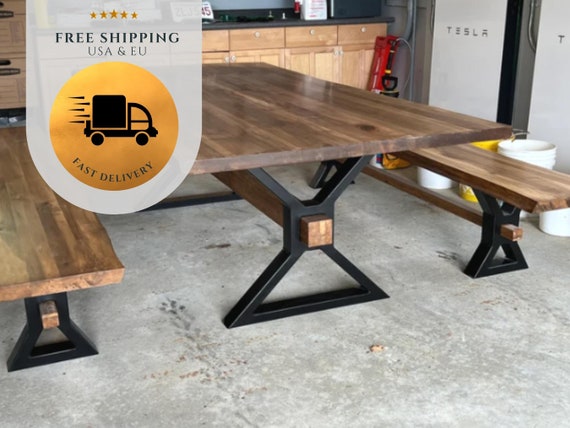A Thorough Appearance at Table Leg Styles: Locating the Ideal Match
Selecting the right dining table leg design is important for both aesthetic charm and functional capability. Typical four legs supply timeless style and security, while the stand base gives raised legroom and a contemporary appearance. For those with larger tables, trestle legs ensure strong assistance, whereas barrette legs present a mid-century modern ambiance with their minimalist design. The x-shaped legs mix contemporary design with boosted stability. Each of these options brings special advantages, making the choice a lot more than simply a matter of preference. Discover additionally to find which style perfectly enhances your dining area and way of life.
Traditional Four Legs
Amongst the numerous kinds of eating table leg styles, the typical four-leg layout stays a classic option for several houses. Four legs give balanced assistance, guaranteeing the table continues to be secure and capable of bearing substantial weight (dining room table legs).
From an aesthetic point of view, the standard four-leg layout can be quickly adjusted to different interior designs. Whether crafted from wood, steel, or a mix of materials, these legs can be elaborately carved, smooth and minimalistic, or anything in between. Their versatility allows them to complement both rustic and modern settings perfectly.
Furthermore, the straightforward structure of the four-leg layout promotes convenience of activity and positioning within a space. Unlike even more facility bases, this design lessens obstructions, providing ample legroom for diners. In summary, the standard four-leg eating table leg style marries sustaining sophistication with useful capability, making it a sharp choice for those seeking both kind and feature in their eating furnishings.
Pedestal Base
Typically commemorated for its stylish and space-efficient layout, the stand base is a notable alternative to the standard four-leg arrangement in dining table leg styles. This distinct base generally features a single central column supporting the table top, which can vary in form, from ornately carved timber to sleek, modern steel. Among the main advantages of the pedestal base is its capability to optimize legroom and seating flexibility. Without edge legs, restaurants are paid for greater freedom of activity, making it a suitable selection for round and oblong tables that promote even more intimate and inclusive gatherings.
Additionally, the pedestal base's central assistance can deal with substantial weight, permitting for the use of larger table tops, such as marble or thick hardwood. This strength coupled with its visual adaptability makes the stand base a popular choice in both standard and modern indoor setups. It can seamlessly integrate with different style motifs, from traditional style to minimalist modernity. Additionally, the central column itself provides a canvas for elaborate styles and artistic expressions, including an aspect of visual rate of interest below the table. In summary, the pedestal base incorporates performance with design, making it a refined and useful option for varied dining settings.
Trestle Legs
Trestle legs provide a robust and timeless foundation for eating tables, characterized by their horizontal cross-bracing and tough assistance beam of lights. Originating from middle ages times, this style has actually evolved yet preserved its important structure, making it a perennial fave in both conventional and contemporary settings. The main trestle beam of light, usually supported by two or even more upright messages, offers extraordinary stability, enabling bigger table sizes without the need for added legs.
A substantial advantage of trestle leg tables is the adequate legroom they offer. Unlike tables with four corner legs, the absence of obstructions at the table's edges gives unobstructed space for chairs and diners, boosting convenience and accessibility. This makes trestle tables optimal for fitting larger gatherings, whether in a dining area or a reception hall.
The visual adaptability of trestle legs is significant. Readily available in a variety of materials such as timber, metal, and composite, they can be finished to enhance a vast array of interior styles. From rustic farmhouse to smooth modern styles, trestle legs can be tailored to suit specific preferences. Their enduring allure and practical benefits make trestle legs an engaging choice for those looking for both design and usefulness in their table.
Hairpin Legs

The charm of barrette legs hinges on their simplicity and convenience - dining room table legs. Offered in a variety of products, including steel and brass, they can be finished in many shades to enhance different interior designs. Whether matched with a rustic wood table top or a modern glass surface area, hairpin legs effortlessly blend capability with a touch of vintage beauty
Resilience is an additional remarkable feature of hairpin legs. In spite of their delicate look, these legs are engineered to bear substantial weight, making sure the dining table continues to be steady and safe. Additionally, they are fairly simple to install, making them a preferred option for DIY lovers and professional furnishings manufacturers alike.
X-Shaped Legs

Built from products such as steel, timber, or a mix of both, X-shaped legs can be tailored to match various style preferences. Steel legs typically lend a smooth and industrial feel, suitable for loft-style apartment or condos and modern dining areas. On the check my blog other hand, wooden X-shaped legs provide a warmer, a lot more rustic appeal, appropriate for farmhouse or diverse insides. The convenience in materials enables homeowners to customize their dining tables to better fit their address general style system.
Moreover, the engineering behind X-shaped legs guarantees even weight distribution, lessening the threat of tottering and improving resilience. This makes them particularly fit for larger table that require extra support. Basically, X-shaped legs mix sensible engineering with contemporary aesthetics, making them an ageless choice for diverse eating atmospheres.
Verdict
An extensive understanding of eating table leg styles exposes the distinct features and benefits of each design. Trestle legs make sure durable support for larger tables, and hairpin legs introduce a mid-century modern aesthetic.